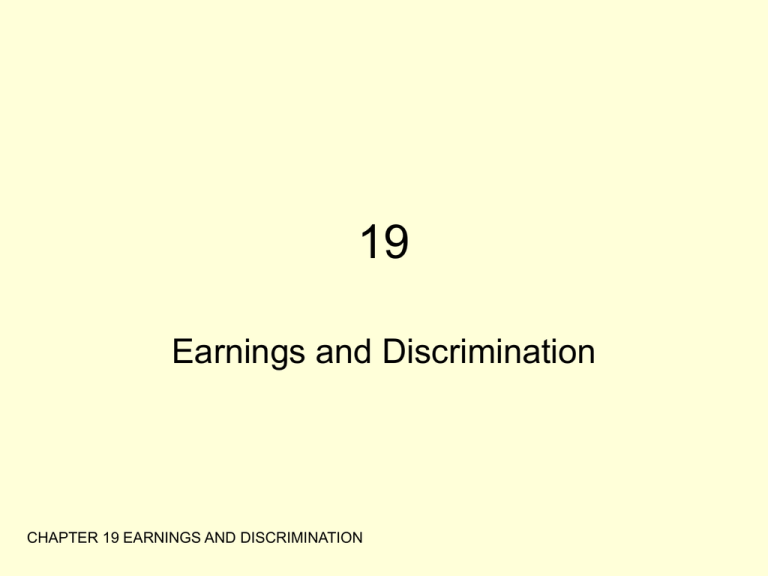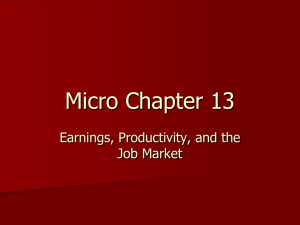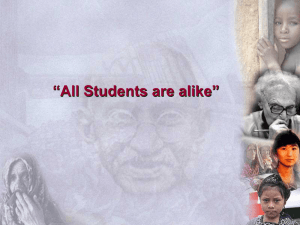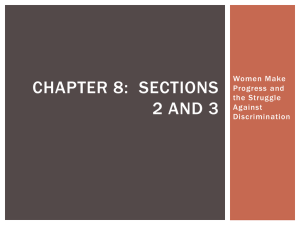
19
Earnings and Discrimination
CHAPTER 19 EARNINGS AND DISCRIMINATION
Earnings Variations
• Differences in Earnings in the United
States Today
– The typical physician earns about $200,000 a
year.
– The typical police officer earns about $50,000
a year.
– The typical farmworker earns about $20,000 a
year.
CHAPTER 19 EARNINGS AND DISCRIMINATION
Earnings and Productivity
• Wages are governed by labor supply and
labor demand.
• Labor demand reflects the marginal
productivity of labor.
• Labor supply reflects the marginal
opportunity cost of work.
CHAPTER 19 EARNINGS AND DISCRIMINATION
Earnings
• In equilibrium, each worker is paid a wage
equal to the value of his or her marginal
product
– MPL is the worker’s contribution to the
economy’s production of goods and services.
– VMPL = MPL price of end product
• This wage is also equal to the marginal
cost of working.
• We saw all this in Chapter 18.
CHAPTER 19 EARNINGS AND DISCRIMINATION
Ch. 18 Figure 4 Equilibrium in a Labor Market
Wage
(price of
labor)
Supply
(Marginal Opportunity
Cost of Labor)
Equilibrium
wage, W
Demand
(Value of the Marginal Product of Labor)
0
Equilibrium
employment, L
CHAPTER 19 EARNINGS AND DISCRIMINATION
Quantity of
Labor
Earnings Variations
• But all this still does not explain why
earnings vary
– from profession to profession and
– from person to person.
CHAPTER 19 EARNINGS AND DISCRIMINATION
SOME DETERMINANTS OF
EQUILIBRIUM WAGES
•
•
•
•
•
Compensating differentials
Human capital
Ability, effort, and chance
Signaling
The superstar phenomenon
CHAPTER 19 EARNINGS AND DISCRIMINATION
Compensating Differentials
• Compensating differential refers to a
difference in wages that offset the different
non-monetary characteristics of different
jobs.
– Coal miners are paid more than others with
similar levels of education.
– Night-shift workers are paid more than dayshift workers.
– Professors are paid less than lawyers and
doctors.
CHAPTER 19 EARNINGS AND DISCRIMINATION
Human Capital
• Human capital is the accumulation of
investments in people. It includes
– education, and
– on-the-job training.
• Higher human capital leads to
– higher productivity and, therefore,
– a higher wage.
CHAPTER 19 EARNINGS AND DISCRIMINATION
Human Capital
• Education represents an expenditure of
resources at one point in time to raise
productivity in the future.
• By the year 2003, a man with a college
degree earned 82 percent more than a
man without one. Women showed a 71
percent increase in earnings due to a
college degree.
CHAPTER 19 EARNINGS AND DISCRIMINATION
Table 1 Average Annual Earnings by
Educational Attainment
The advantage of college education is large and increasing.
CHAPTER 19 EARNINGS AND DISCRIMINATION
The Increasing College Premium
• Why has the gap in earnings between
skilled and unskilled workers risen in
recent years? Here are two hypotheses:
– Globalization provides more opportunities for
our skilled labor and reduces the need for our
unskilled labor.
– Technological progress has increased the
need for skilled labor and reduced the need
for unskilled labor.
CHAPTER 19 EARNINGS AND DISCRIMINATION
Ability, Effort, and Chance
• High natural ability leads to high
productivity and a high wage.
• One’s love of leisure and one’s natural
ability determine one’s effort. Effort
determines productivity and the wage.
• These characteristics of a worker are
determined by chance.
• Chance also determines whether one
chooses the right career.
CHAPTER 19 EARNINGS AND DISCRIMINATION
The Benefits of Beauty
• A 1994 poll was used to rank a set of
pictures of people by beauty
• After controlling for education, job
experience, profession, and other
standard determinants of wages, it was
found that people considered more
attractive than average earned 5 to 10
percent more than those considered less
attractive than average.
• Why does beauty make a difference?
CHAPTER 19 EARNINGS AND DISCRIMINATION
CHAPTER 19 EARNINGS AND DISCRIMINATION
Photo by Udayan Roy
An Alternative View of Education:
Signaling
• According to another theory, education
does not improve productivity.
• Firms use educational attainment as a way
of sorting between high-ability and lowability workers.
– It is rational for firms to interpret a college
degree as a signal of ability. As a result, the
college-educated earn more even though
college is a waste of time.
CHAPTER 19 EARNINGS AND DISCRIMINATION
Education: does it really help?
• The human capital approach is probably
true for those with professional degrees
• The signaling approach may be true for
liberal arts majors
CHAPTER 19 EARNINGS AND DISCRIMINATION
The Superstar Phenomenon
• Superstars arise in markets that exhibit the
following characteristics:
– Every customer in the market wants to enjoy
the good supplied by the best producer.
– The good is produced with a technology that
makes it possible for the best producer to
supply every customer at a low cost.
– In such a market wages vary a great deal
more than ability does.
CHAPTER 19 EARNINGS AND DISCRIMINATION
Above-Equilibrium Wages
• The equilibrium theory of wages that you
saw in chapter 18 does not always apply
(Sorry!)
• In some cases, the wage exceeds the
equilibrium wage. Why?
– Minimum-wage laws
– Market power of labor unions
– Efficiency wages
CHAPTER 19 EARNINGS AND DISCRIMINATION
Above-Equilibrium Wages: Unions
• A union is a worker association that
bargains with employers over wages and
working conditions.
• A union’s final weapon is a strike. A strike
refers to the organized withdrawal of labor
from a firm by a union.
• Union workers earn 10 to 20 percent more
than similar non-union workers
CHAPTER 19 EARNINGS AND DISCRIMINATION
Above-Equilibrium Wages: Efficiency Wages
• The theory of efficiency wages holds that a
firm can find it profitable to pay high wages
because doing so increases the
productivity of its workers. High wages
may:
– reduce worker turnover.
– increase worker effort.
– raise the quality of workers that apply for jobs
at the firm.
CHAPTER 19 EARNINGS AND DISCRIMINATION
THE ECONOMICS OF
DISCRIMINATION
• Wages are also affected by discrimination.
• Discrimination occurs when the
marketplace offers different opportunities
to similar individuals who differ only by
race, ethnic group, sex, age, or other
personal characteristics.
CHAPTER 19 EARNINGS AND DISCRIMINATION
Measuring Labor-Market Discrimination
• Discrimination is often measured by
looking at the average wages of different
groups.
CHAPTER 19 EARNINGS AND DISCRIMINATION
Measuring Labor-Market Discrimination
• Even in a labor market free of
discrimination, different people have
different wages.
CHAPTER 19 EARNINGS AND DISCRIMINATION
Measuring Labor-Market Discrimination
• People differ in the amount of human
capital they have and in the kinds of work
they are willing and able to do.
CHAPTER 19 EARNINGS AND DISCRIMINATION
Measuring Labor-Market Discrimination
• Simply observing differences in wages
among broad groups—white and black,
men and women—says little about the
prevalence of discrimination.
CHAPTER 19 EARNINGS AND DISCRIMINATION
Table 2 Median Annual Earnings
by Race and Sex
Do these facts prove discrimination?
CHAPTER 19 EARNINGS AND DISCRIMINATION
Measuring Labor-Market Discrimination
• Because the differences in average wages
among groups in part reflect differences in
human capital and job characteristics, they
do not by themselves say anything about
how much discrimination there is in the
labor market.
CHAPTER 19 EARNINGS AND DISCRIMINATION
Discrimination by Employers
• The fact that discrimination is hard to
measure does not mean that it does not
happen.
• Firms may discriminate in their hiring.
However,
• Firms that do not discriminate will have
lower labor costs when they hire the
employees who have been discriminated
against.
CHAPTER 19 EARNINGS AND DISCRIMINATION
Discrimination by Employers
• Nondiscriminatory firms will tend to outcompete and replace firms that
discriminate.
CHAPTER 19 EARNINGS AND DISCRIMINATION
Discrimination by Employers
• Competitive markets tend to limit the
impact of discrimination on wages.
• Firms that do not discriminate will be more
profitable than those firms that do
discriminate.
CHAPTER 19 EARNINGS AND DISCRIMINATION
Discrimination by Customers and
Governments
• Although the profit motive is a strong force
acting to eliminate discriminatory wage
differentials, there are limits to its
corrective abilities.
– Customer preferences
– Government policies
CHAPTER 19 EARNINGS AND DISCRIMINATION
Discrimination by Customers
• If customers have
discriminatory preferences,
firms may discriminate for
profitability reasons.
• This will happen when
customers are willing to pay to
maintain the discriminatory
practice.
CHAPTER 19 EARNINGS AND DISCRIMINATION
Discrimination in sports
• According to a 1988 study, black basketball
players earned 20 percent less than white
players of comparable ability.
• A possible explanation is discrimination by fans.
• Late 1960s data showed that black baseball
players earned less than white players of similar
ability
• A 1990 study found that baseball cards for black
hitters (pitchers) sold for 10 percent (13 percent)
less than cards for comparable white hitters
(pitchers)
CHAPTER 19 EARNINGS AND DISCRIMINATION
Discrimination by Governments
• When the government mandates
discriminatory practices or requires firms
to discriminate, this may lead to
discriminatory wage differentials.
• Streetcars in the southern states in the
early 20th century practiced racial
discrimination in seating under the
pressure of government laws. These laws
were resisted by the firms because of
adverse effects on profitability.
CHAPTER 19 EARNINGS AND DISCRIMINATION
Any Questions?
CHAPTER 19 EARNINGS AND DISCRIMINATION
Summary
• Workers earn different wages for many
reasons.
• To some extent, wage differentials
compensate workers for job attributes.
• Workers with more human capital get paid
more than workers with less human
capital.
CHAPTER 19 EARNINGS AND DISCRIMINATION
Summary
• The return to accumulating human capital
is high and has increased over the past
decade.
• There is much variation in earnings that
cannot be explained by things economists
can measure.
CHAPTER 19 EARNINGS AND DISCRIMINATION
Summary
• The unexplained variation in earnings is
largely attributable to natural ability, effort,
and chance.
• Some economists have suggested that
more-educated workers earn higher
wages because workers with high natural
ability use education as a way to signal
their high ability to employers.
CHAPTER 19 EARNINGS AND DISCRIMINATION
Summary
• Wages are sometimes pushed above the
equilibrium level because of minimumwage laws, unions, and efficiency wages.
• Some differences in earnings are
attributable to discrimination on the basis
of race, sex, or other factors.
• When measuring the amount of
discrimination, one must correct for
differences in human capital and job
CHAPTER 19 EARNINGS AND DISCRIMINATION
characteristics.
Summary
• Competitive markets tend to limit the
impact of discrimination on wages.
• Discrimination can persist in competitive
markets if customers are
– willing to pay more to discriminatory firms,
– or if the government passes laws requiring
firms to discriminate.
CHAPTER 19 EARNINGS AND DISCRIMINATION









